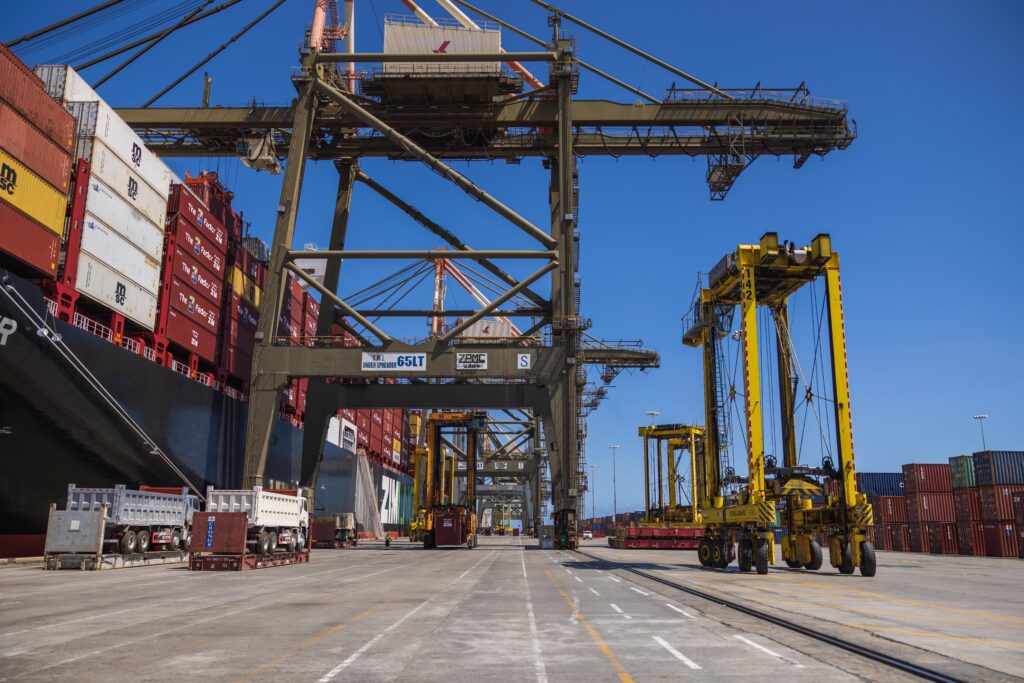Cargo Operations
Explore the intricate world of cargo operations and discover how goods travel across the globe to Jamaica and its operations.
The Journey of Cargo:
From Dock to Destination
Cargo operations in Jamaica involve the handling, storage, and transportation of goods through the country’s ports, which are critical hubs for both imports and exports. These operations include the loading and unloading of various types of cargo, such as containerized goods, bulk commodities like bauxite, and breakbulk items. Jamaica’s strategic location in the Caribbean makes its ports, particularly the Port of Kingston, vital links in global trade routes, serving as key transshipment points where cargo is transferred between ships for distribution across the Americas, Europe, and beyond.
Where It All Begins: The Ports
Ports are vital hubs in cargo operations, acting as the primary points where goods are transferred between sea and land. They are essential to global trade, ensuring the smooth movement of goods across international borders. In Jamaica, major ports like the Port of Kingston are central to the country’s cargo operations, providing critical infrastructure and services that facilitate the handling, storage, and distribution of goods.
The Kingston Port is the largest and most important port in Jamaica, known for being a major container transshipment hub in the Caribbean.
The Montego Bay Port is Primarily serves the tourism industry but also handles general cargo and supports regional trade.
The Ocho Rios Port is Known for handling both cargo and cruise operations, particularly important for exporting bauxite.
The Falmouth Port is primarily a cruise ship port, but also has facilities for handling some cargo.
Key Roles of Ports in Cargo Operations
Loading and Unloading Cargo
Ports are equipped with specialized cranes and handling equipment to efficiently load and unload cargo from ships. This process is meticulously coordinated to ensure that goods are transferred swiftly and safely, minimizing the time ships spend docked.
Storage and Warehousing
Ports provide extensive storage facilities where goods can be stored temporarily before being transported to their final destinations. This includes container yards, warehouses, and specialized storage for perishable or hazardous goods.
Customs and Regulatory Compliance
Ports serve as key points for customs clearance, where goods are inspected and documented to ensure they meet all legal and regulatory requirements. This process is crucial for the legal import and export of goods.
Transshipment Hubs
Some ports, like the Port of Kingston, function as transshipment hubs where cargo is transferred from one vessel to another for further shipment. This role is particularly important for connecting different trade routes and ensuring the efficient global distribution of goods.
Logistics and Distribution
Ports are critical links in the logistics chain, connecting maritime transport with road, rail, and air networks. This connectivity allows for the efficient distribution of goods to various parts of the country and beyond.
Economic Impact
Ports are economic powerhouses, generating significant employment and attracting investment. They support a wide range of industries, from manufacturing to retail, by providing the necessary infrastructure for importing raw materials and exporting finished goods.
Step-by-Step process of Cargo Handling
Cargo handling involves a complex, step-by-step process that ensures goods are safely and efficiently transported from the point of origin to their final destination. This process includes several stages, from loading at the port to unloading, customs clearance, and distribution. Here’s an outline of the entire process:
1. Pre-Loading Preparation
a. Cargo Documentation
- Documentation: Before cargo arrives at the port, all necessary documents are prepared. This includes the Bill of Lading, Commercial Invoice, Packing List, and any special permits required for specific types of goods.
- Booking Shipping Space: The shipper books space on a vessel through a shipping line or freight forwarder, specifying the type and quantity of cargo to be transported.
b. Cargo Inspection and Packaging
- Inspection: Cargo is inspected to ensure it meets the required standards and regulations, including weight, packaging, and labeling.
- Packaging: Goods are properly packaged to withstand handling, transportation, and storage conditions. For example, containerized cargo is loaded into standardized containers, while breakbulk cargo might require crates or pallets.
2. Loading at the Port of Origin
a. Transport to the Port
- Inland Transportation: The cargo is transported from the origin (e.g., a factory or warehouse) to the port using trucks, trains, or barges.
- Gate-in Process: Upon arrival at the port, the cargo undergoes a gate-in process, where documentation is checked, and the cargo is registered for loading onto the ship.
b. Port Handling and Loading
- Staging: Cargo is temporarily stored in a staging area or container yard within the port, organized for efficient loading.
- Loading onto the Vessel: The cargo is loaded onto the ship using cranes, conveyors, or forklifts, depending on the type of cargo (containerized, bulk, breakbulk, or liquid bulk). The loading process is carefully planned to ensure the vessel’s stability and safety.
3. Shipping
a. Departure from Port
- Ship Departure: Once all cargo is loaded, the vessel departs from the port according to its schedule. The shipping line provides updates on the vessel’s location and estimated time of arrival (ETA) at the destination port.
b. Voyage
- Transit: During the voyage, the cargo is secured to prevent shifting and damage. The ship’s crew monitors the cargo and vessel conditions, making adjustments as necessary.
4. Arrival at the Destination Port
a. Pre-Arrival Notification
- Notification: The shipping line notifies the destination port and the consignee (receiver) of the ship’s impending arrival. This includes providing an estimated time of arrival (ETA) and submitting necessary documents for customs clearance.
b. Unloading
- Port Entry: Upon arrival, the vessel is assigned a berth at the destination port. The port authorities may conduct an initial inspection to ensure compliance with local regulations.
- Unloading: The cargo is unloaded from the ship using appropriate equipment. Containerized cargo is placed in container yards, bulk cargo in storage silos, and liquid bulk in tanks.
5. Customs Clearance
a. Documentation Submission
- Customs Declaration: The consignee or their customs broker submits a customs declaration along with all relevant documentation (e.g., Bill of Lading, Commercial Invoice, Packing List) to the customs authorities at the destination port.
b. Inspection and Assessment
- Inspection: Customs authorities may inspect the cargo to verify its contents and ensure it complies with local laws and regulations.
- Duty and Taxes: Customs calculates any applicable duties and taxes based on the cargo’s value, type, and origin. These must be paid before the cargo can be released.
6. Distribution
a. Transport to Final Destination
- Inland Transportation: The cargo is loaded onto trucks, trains, or other modes of transport to be delivered to the final destination, such as a warehouse, distribution center, or directly to the consignee’s facility.
- Coordination: The consignee coordinates with local logistics providers to ensure the timely delivery of the cargo.
b. Final Delivery
- Delivery and Inspection: Upon arrival at the final destination, the cargo is inspected to ensure it has arrived in good condition. Any discrepancies or damages are reported to the shipping line or insurance provider.
- Storage or Further Distribution: Depending on the nature of the cargo, it is either stored in a warehouse or immediately distributed to retailers, manufacturers, or end-users.
7. Post-Delivery Documentation and Payment
a. Final Documentation
- Proof of Delivery: The consignee provides a proof of delivery (POD) to the shipping line or logistics provider, confirming that the cargo has been received in good condition.
- Payment Settlement: Any outstanding payments for transportation, duties, and services are settled.
b. Record Keeping
- Document Archiving: All relevant documents, including the Bill of Lading, customs documents, and proof of delivery, are archived for record-keeping and compliance purposes.
Modernizing the Trade: Technology in Cargo Operations
Technology plays a crucial role in enhancing the efficiency and security of cargo operations. By integrating advanced digital systems, automation, and specialized port management software, ports and logistics providers can streamline processes, reduce errors, and improve the overall safety and reliability of cargo handling
Driving the Economy: The Impact of Cargo Operations
Cargo operations play a vital role in the economic development of Jamaica by contributing to job creation, trade facilitation, and overall economic growth. The strategic location of Jamaica in the Caribbean, along with its well-developed port infrastructure, makes it a critical hub for international trade. The chart shows the employment rate throughout the years
No Data Found
Looking Ahead: The Future of Cargo Operations
The future of cargo operations is being shaped by several key trends that focus on sustainability, technology, and adaptability to global trade changes. These trends are transforming how ports and logistics providers operate, aiming to enhance efficiency, reduce environmental impact, and respond to evolving market demands.

Green Shipping
Green shipping refers to the adoption of environmentally friendly practices in the maritime industry to reduce the environmental footprint of cargo operations. This trend is driven by global regulatory pressures, increasing consumer demand for sustainable products, and the need to mitigate the impacts of climate change.
Smart Port
Smart ports integrate advanced digital technologies to enhance the efficiency, safety, and sustainability of cargo operations. These technologies include the Internet of Things (IoT), artificial intelligence (AI), big data analytics, and blockchain.
Impact of Global Trade Changes
Global trade is constantly evolving due to factors such as geopolitical tensions, trade agreements, economic shifts, and changes in consumer behavior. Cargo operations must adapt to these changes to remain competitive and resilient.
Dr. Elaine Thompson: A futurist and maritime economist, believes that Jamaica is poised to become a hub for futuristic port and cargo handling technologies. With its strategic location in the Caribbean, the country can leverage its ports to serve as a critical node in global trade routes. The future of ports lies in automation, sustainability, and connectivity. Jamaica’s investment in smart port infrastructure and green technologies will enhance its competitiveness and set a new standard in the region for efficiency and environmental responsibility. As global trade dynamics evolve, Jamaica’s ports will play a vital role in supporting economic resilience and growth across the Caribbean and beyond.

The Lifeline of Global Trade
Recap the importance of cargo operations and how they connect the world. Encourage readers to explore more or get involved in the industry.
